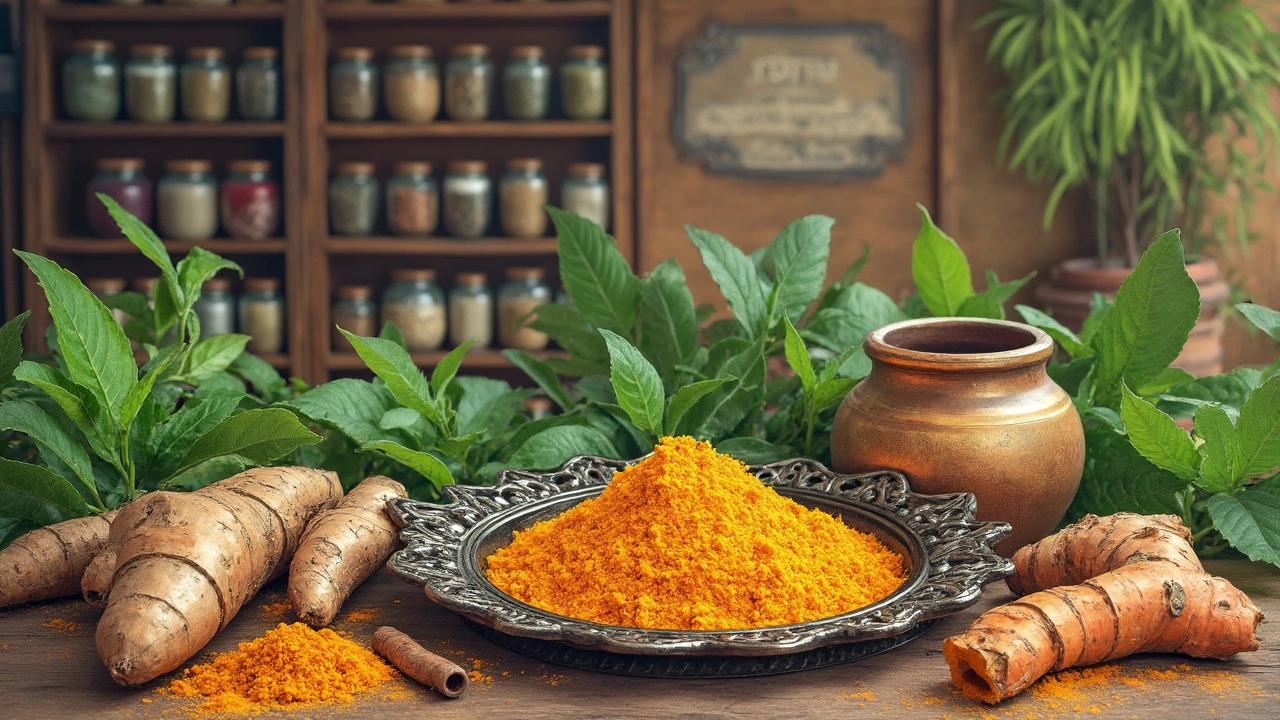- Home
- ::
- Discover the King of All Herbs: Benefits, History, and Everyday Uses

Discover the King of All Herbs: Benefits, History, and Everyday Uses
They call it the 'king of all herbs'—but what makes tulsi (Holy Basil) almost legendary wherever it’s known? Forget about the usual hype when it comes to trendy supplements or superfoods. This humble green leaf, rooted deep in ancient traditions, wears the crown for reasons that go far beyond taste or aroma. Step into a kitchen in India, a wellness store in London, or even a science lab, and you’ll see tulsi stealing the limelight—whether it’s in a steaming cup of tea or crushed into a healing poultice. There’s no other herb that manages to be this spiritual, medicinal, and versatile at once. Yet, most people in the UK don’t even know they’ve walked past it, let alone tasted it in their lives.
The Legendary Story: How Tulsi Became King
Glance at ancient texts or visit a traditional Indian home, and tulsi is almost always there—on the doorstep, in a little clay pot, or woven into daily rituals. Its Latin name, Ocimum sanctum, hints at its holy status. The story starts thousands of years ago, with Ayurvedic practitioners describing tulsi as "the incomparable one." It’s not just a plant—it’s part of daily life, symbolizing purity and wellbeing. According to Vedic legend, tulsi wasn’t just revered for its health effects. It was so sacred that people housed a living tulsi plant right at their entrance, believing it would ward off negative energy. Tulsi has even been used as a protective charm, woven into wedding garlands, or crushed and added to sacred water.
But this isn’t just about tradition—science is catching up. In 2017, the Journal of Ayurveda and Integrative Medicine published a review confirming tulsi’s adaptogenic qualities. Adaptogens help your body handle stress more efficiently, making tulsi both ancient medicine and modern ally for life’s chaos. If you’re picturing old potions or mysterious tonics, think again: it’s as simple as a few leaves in your morning tea.
Imagine my Indian grandmother swearing by her cup of tulsi tea each morning, before she did her daily yoga. Even when I moved to London, she still mailed small packets to make sure I’d never run out. That kind of devotion, passed down through generations, isn’t all about nostalgia—it’s about results people have seen and felt for centuries.
What Makes Tulsi Truly Special: Health Benefits Unpacked
You’re probably asking, what’s in tulsi that makes it the star of the herbal world? First off, researchers have spotted over 200 bioactive compounds packed into its small leaves. These include eugenol, carvacrol, linalool, and dozens of essential oils that together deliver a real punch. The main headline is its role as an adaptogen—meaning it helps balance cortisol (your stress hormone), and gives your nervous system a proper reset. Ever felt your brain spinning after a rough day? A hot mug of tulsi tea really can steady your nerves, and that effect is measurable. In one clinical study performed at the All India Institute of Medical Sciences, participants who drank tulsi tea daily reported a 31% drop in self-rated stress levels within just four weeks.
Tulsi doesn’t stop at stress management. It’s naturally antibacterial and antiviral—a big help when everyone around you is sneezing on the Tube. No wonder traditional medicine suggested chewing fresh tulsi leaves during cold season. In fact, a cup of tulsi infusion before bed is a home remedy my friends reach for more than any paracetamol. And then there’s its anti-inflammatory mojo. Those with mild arthritis or stiff joints often notice less aching after incorporating tulsi into daily routines. Researchers have drawn links between its regular use and improved markers of inflammation on blood tests. Got digestive trouble? Tulsi’s essential oils stimulate your stomach’s natural juices, helping you break down a heavy meal. That’s why it appears in so many after-dinner drinks in South Asia.
The most mind-blowing part? Tulsi supports blood sugar balance. A study published in the Indian Journal of Clinical Biochemistry tracked people with type 2 diabetes, and those given tulsi extract for six months saw their fasting blood sugar drop by an average of 18 mg/dl. This matters hugely when you’re looking for natural ways to support metabolism without worrying about side effects.
If that’s not impressive enough, tulsi is a potent antioxidant powerhouse. It protects cells from oxidative stress—the process that accelerates aging and contributes to chronic disease. In short, tulsi is less about hype, more about real science in your daily cup.
| Nutrient | Per 100g Fresh Tulsi Leaves |
|---|---|
| Vitamin A | 5275 IU |
| Vitamin C | 18 mg |
| Calcium | 177 mg |
| Iron | 3.2 mg |
| Protein | 3.2 g |
As Dr. Vishwanath Guddadar once put it:
"Tulsi stands out as a true 'adaptogen' in Ayurveda and modern science alike. Its many active molecules offer calm, resilience, and immune support, making it the king among herbs."

Everyday Ways to Use Tulsi (Even in a London Flat)
You might think tulsi’s only for old-school recipes or ancient temples—but let’s get real. It’s pretty easy to fit tulsi into a busy urban life, whether you’re working from a coworking space, hustling your way through rush hour, or unwinding at home. First up: tulsi tea is everywhere now. Just steep a handful of fresh leaves—or a teaspoon of dried tulsi—in boiling water for five minutes. Add lemon, honey, or a wedge of ginger if you like extra kick. Swap out your afternoon coffee, and see if you notice a lighter, cleaner sense of energy.
Don’t have a green thumb? No sweat. Tulsi seeds are common in Indian stores across London—just drop them in a small pot near a sunny window, water once a day, and they’ll sprout in days. Even a small flat can grow a steady supply. If planting isn’t your vibe, grab dried tulsi from specialty grocers, or order online—even supermarkets are catching on. Just check the label for pure king of herbs (Ocimum sanctum), not “thai basil” or common basil, which are totally different plants.
Tulsi leaf isn’t just for tea. Toss a few fresh leaves onto your salad. Mix them into your favorite smoothie for a peppery, earthy hint. Even pesto gets a spicy upgrade with tulsi instead of standard basil. Kids refusing cough syrup? Crushed tulsi with honey is an age-old trick (just don’t give honey to babies under 12 months). If you’re big on essential oils, try a few drops of tulsi oil in your diffuser at night. This fills your room with a gentle, relaxing scent—great for winding down, especially when your brain just won’t switch off.
Here’s a quick list for getting started:
- Brew tulsi tea at least once a day, morning or evening
- Chop fresh tulsi into salads, soups, or sauces
- Blend dried tulsi into smoothies or sprinkle on yoghurt
- Use tulsi-infused oil for a natural skin remedy (it helps calm rashes and insect bites)
- Burn tulsi incense or use the essential oil in your diffuser for destressing
It’s not about replacing your entire medicine cabinet. It’s about adding one simple ritual—one that’s backed by stories, science, and centuries of use. Whether you’re chasing energy, better sleep, a stronger immune system, or just a little calm in the storm of city life, tulsi’s ready to help.
Debunking Myths and Answering Big Questions
Like any “miracle herb,” tulsi comes with a load of myths and half-truths. So, let’s bust out a few facts. First: Is tulsi safe for everyone? Most people can handle tulsi well, but if you’re pregnant, breastfeeding, or on blood thinners, talk to your doctor first. Tulsi may slow blood clotting a little, so it’s smart to double-check. As with any herb, moderation is key—a cup or two a day is plenty for most.
People often confuse tulsi with basil you find at the supermarket. They're distant cousins, but common basil (Ocimum basilicum) is more about flavor, while tulsi is all about health. It’s got a stronger, earthier taste and a whole different set of active compounds—that’s why Indian cooks and healers use it so differently.
Another myth? That you can only use tulsi fresh. Dried tulsi keeps most of its potency and is even more convenient for busy schedules. Just keep it in an airtight jar away from sunlight. Some folks swear by tulsi capsules, especially when traveling, though I find the taste is half the magic.
Worried about allergies? Reactions to tulsi are super rare, though if you’re sensitive to mint family plants, start slow. And don’t believe the scare stories about drug interactions—there’s zero evidence tulsi messes up everyday medicines like statins or blood pressure pills in normal doses. Still, herbs aren’t magic. They work best as part of an overall healthy routine—not a replacement for medicine when you really need it.
For those wondering about sustainability: Tulsi is easy to grow and harvest. Most suppliers in the UK now source responsibly, working directly with small farmers. Growing your own, even in a pot, takes the guesswork out and gives you full control of quality and freshness.
To sum up the buzz, tulsi earns its crown as the king of all herbs because it does so much with so little effort. It folds into every part of life—body, mind, and spirit. When science, history, and daily wellness come together like this, it’s hard not to pay attention. If you haven’t tried tulsi yet, there’s no better time to give your body a taste of ancient royalty, right in your modern mug.

 Health and Wellness
Health and Wellness





Write a comment